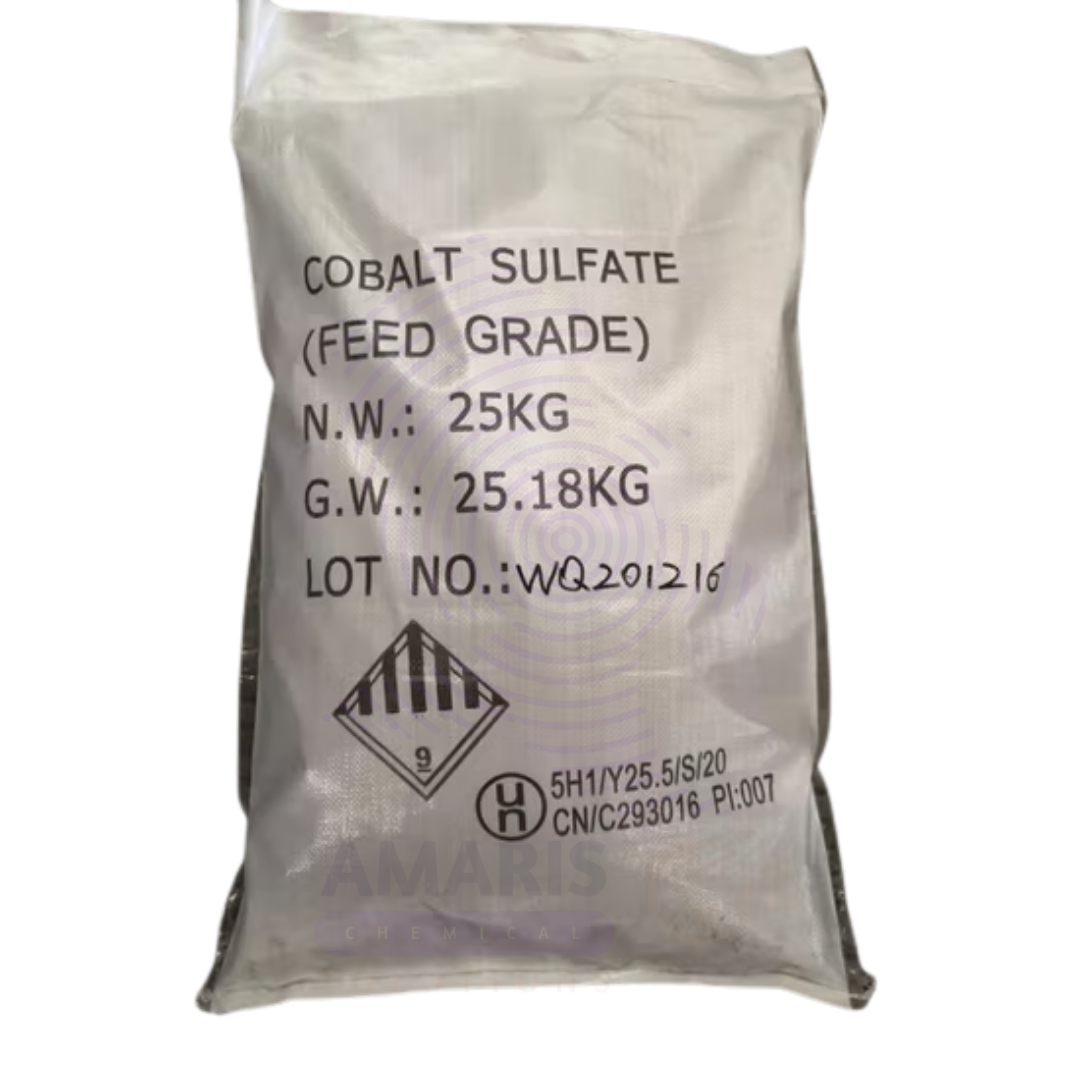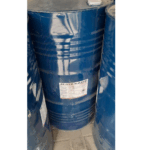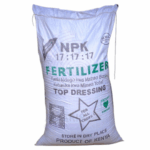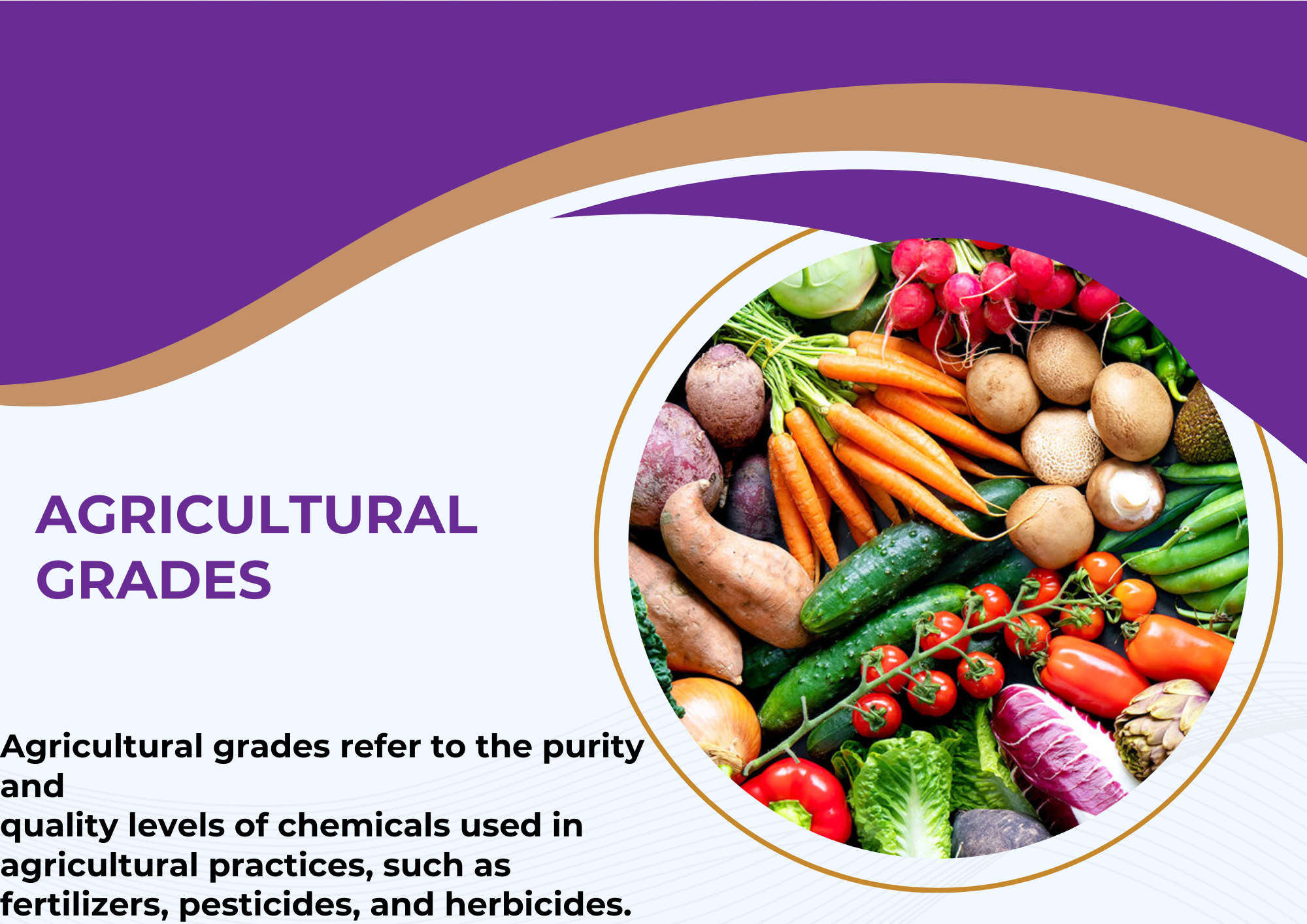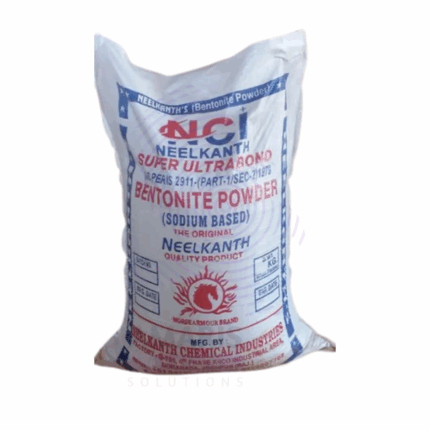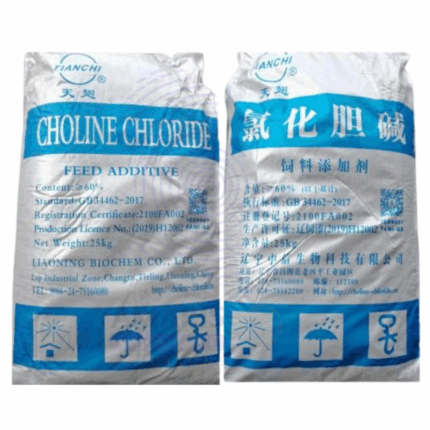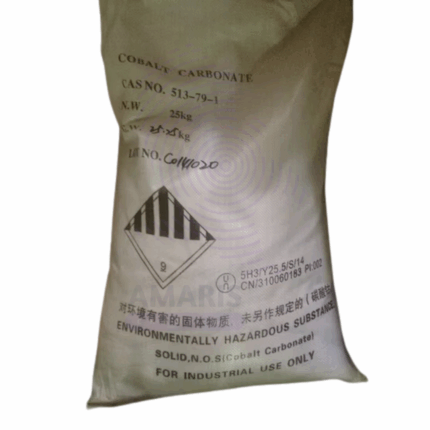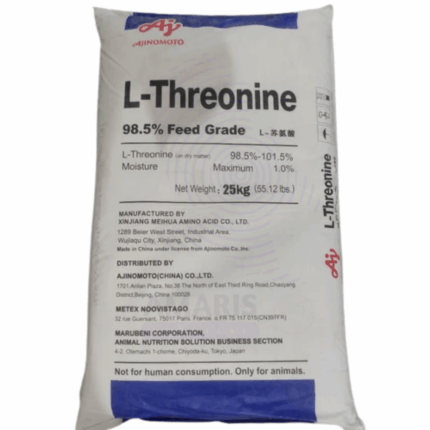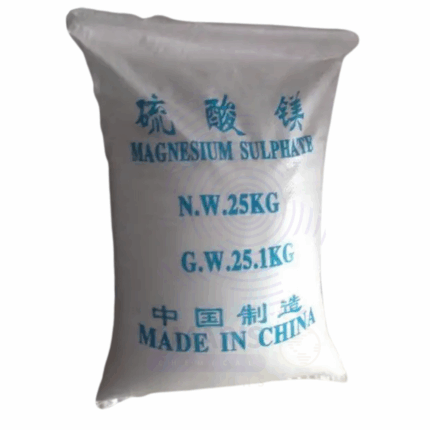Cobalt Sulphate Feed Grade
Whatsapp Order
Cobalt Sulphate Feed Grade is a cobalt salt of sulfuric acid, typically appearing as a pink to reddish crystalline powder or granules. It is specifically manufactured and purified for use as a trace mineral supplement in animal nutrition. Cobalt is an essential trace element required in small amounts for the synthesis of vitamin B12 (cobalamin) in ruminants, playing a vital role in maintaining proper metabolism, growth, and overall health. Feed grade cobalt sulfate ensures safe, bioavailable cobalt supply to livestock such as cattle, sheep, goats, and poultry, supporting rumen microbial activity, appetite, and red blood cell production.
Description
Table of Contents
Toggle
Cobalt Sulphate Feed Grade
Primary Uses
- Animal Feed Additive
- Used as a trace mineral supplement in feed formulations for ruminants (cattle, sheep, goats) to prevent cobalt deficiency.
- Supports vitamin B12 biosynthesis by ruminal microorganisms, crucial for energy metabolism and red blood cell formation.
- Enhances growth performance, feed efficiency, and reproductive health in livestock.
- Used in premixes, mineral blocks, and feed concentrates for balanced mineral nutrition.
- Important in poultry feed in minor quantities to support enzyme function and metabolism.
- Veterinary Nutritional Supplement
- Formulated into veterinary mineral supplements and injectable solutions to treat or prevent cobalt deficiency.
- Supports prevention of metabolic disorders related to cobalt insufficiency such as “bush sickness” and anemia in grazing animals.
Secondary Uses
- Fertilizers & Soil Amendments
- Occasionally used in trace element fertilizers to correct cobalt-deficient soils, improving plant nutrition and indirectly supporting forage quality.
- Industrial Applications
- Utilized in certain chemical syntheses or electroplating processes where cobalt salts are required (though feed grade is not ideal for industrial use).
- Research & Laboratory
- Employed in animal nutrition research and formulation studies to assess mineral bioavailability and metabolic effects.
PRODUCT KEY FEATURES
1. Basic Identification Attributes
- Chemical Name (IUPAC): Cobalt(II) sulfate heptahydrate (most common hydrate form)
- Common/Trade Name: Cobalt Sulphate Feed Grade
- CAS Number: 10124-43-3
- HS Code: 2833.29.00
- Molecular Formula: CoSO₄·7H₂O (heptahydrate)
- Synonyms:
- Cobalt(II) sulfate
- Cobaltous sulfate
- Cobalt sulfate heptahydrate
2. Physical & Chemical Properties
- Physical State: Crystalline powder or granules
- Color & Odor: Pink to reddish crystals; odorless
- Melting Point: Decomposes > 100°C (loses water of hydration)
- Boiling Point: Not applicable (decomposes before boiling)
- Density: ~2.40 g/cm³ (anhydrous form)
- Solubility:
- Highly soluble in water (≈ 100 g/100 mL at 20°C)
- Insoluble in organic solvents
- Stability: Stable under normal conditions; hygroscopic
3. Safety & Hazard Attributes
- Hazard Class (GHS): Harmful if swallowed; may cause skin and respiratory irritation; suspected carcinogen (cobalt compounds)
- NFPA Ratings:
- Health: 2
- Flammability: 0
- Reactivity: 0
- Exposure Limits: OSHA PEL for cobalt metal and compounds = 0.1 mg/m³ (TWA)
- Toxicity: Moderate toxicity in high doses; chronic exposure may cause lung and heart effects; essential trace nutrient at low doses
- Reactivity: Stable; avoid mixing with strong oxidizers
4. Storage & Handling Attributes
- Storage Conditions: Store in tightly sealed containers in a cool, dry, well-ventilated area away from incompatible materials
- Container Type: Polyethylene or fiber drums, sacks with moisture barriers
- Shelf Life: Typically 2–3 years if stored properly
- Special Handling:
- Use dust control measures to avoid inhalation
- Employ PPE such as gloves, dust masks, and goggles when handling powder
5. Regulatory & Compliance Attributes
- FDA Status: Approved as a feed additive under FDA regulations (21 CFR Part 573)
- REACH Status: Registered under EU chemical regulations for feed use
- Transportation: Non-hazardous for transport in feed grade form; check local regulations
- Waste Disposal: Dispose in accordance with local environmental laws; avoid release to waterways
6. Environmental & Health Impact
- Ecotoxicity: Low environmental hazard when used properly; cobalt salts can be toxic to aquatic life at high concentrations
- Persistence: Moderately persistent in soils
- Bioaccumulation: Not expected to bioaccumulate significantly
- Carcinogenicity/Mutagenicity: Classified as possibly carcinogenic to humans by IARC (Group 2B) for cobalt compounds generally
- Biodegradability: Inorganic salt, not biodegradable but stable
SAFETY HANDLING PRECAUTIONS
Safety Handling Precautions
Personal Protective Equipment (PPE):
- Dust mask or respirator
- Gloves resistant to chemical penetration
- Safety goggles
- Protective clothing
Handling Measures:
- Avoid generating dust; use adequate ventilation
- Avoid inhalation and skin contact
- Follow good hygiene practices
Storage Measures:
- Keep container tightly closed and dry
- Store away from incompatible materials such as strong oxidizers
Hygiene Practices:
- Wash hands thoroughly after handling
- Do not eat, drink, or smoke when handling product
First Aid Measures
- Inhalation: Move to fresh air; seek medical attention if respiratory irritation or difficulty occurs
- Skin Contact: Wash affected area with soap and water; seek medical attention if irritation develops
- Eye Contact: Rinse eyes thoroughly with water for at least 15 minutes; seek medical care if irritation persists
- Ingestion: Rinse mouth; seek immediate medical attention
Firefighting Measures
- Fire Hazards: Non-flammable; may release toxic cobalt fumes if heated to decomposition
- Extinguishing Media: Use water spray, foam, dry chemical, or CO₂ as appropriate for surrounding fire
- Special Precautions: Firefighters should wear protective gear and self-contained breathing apparatus if exposed to cobalt fumes
- Decomposition Products: Toxic cobalt oxides and sulfur oxides may form at high temperatures
Related products
Acid Oil Soya
Acid Oil Soya is a byproduct derived from the refining of soybean oil. It is a dark-colored, free fatty acid-rich liquid containing mainly oleic and linoleic acids. Acid Oil Soya is commonly used in industrial applications such as soap making, animal feed, and as a raw material in the production of biodiesel, lubricants, and other chemicals.
Bentonite Powder
Bentonite powder is a naturally occurring absorbent clay primarily composed of montmorillonite, a type of smectite clay mineral. It exhibits excellent swelling and water absorption properties, making it highly versatile in industrial and commercial applications. Bentonite forms a gel-like substance when mixed with water, which imparts viscosity and plasticity. It is used extensively for its binding, sealing, and adsorptive characteristics. Its fine powder form allows for easy incorporation in various processes including drilling, foundry, cosmetics, pharmaceuticals, and agriculture.
Choline Chloride Powder
Choline Chloride Powder is a white to off-white crystalline powder containing 60% choline chloride, a quaternary ammonium salt essential as a nutrient in animal and poultry feed. It serves as a vital source of choline, an important component in fat metabolism, liver function, and cell membrane integrity. Produced through chemical synthesis, this powder form is highly soluble in water, making it easy to incorporate into feed premixes and supplements. Choline chloride is widely used in the agriculture industry to prevent choline deficiency, enhance growth performance, and improve overall health in livestock. Beyond animal nutrition, it finds applications in chemical manufacturing and pharmaceuticals.
Cobalt Carbonate
Cobalt Carbonate is a rose-red to purplish powder with a metal content of approximately 46% cobalt by weight. It is an inorganic compound primarily used as a source of cobalt, either as a raw material in chemical synthesis or as a micronutrient in various formulations. It is slightly soluble in water and decomposes upon heating, releasing carbon dioxide and leaving cobalt oxide (CoO). Cobalt Carbonate is used in ceramics, catalysts, animal nutrition, batteries, and metal surface treatments. Its controlled release of cobalt makes it useful in both industrial and biological applications.
L-Threonine Feed Grade
L-Threonine Feed Grade is a high-purity essential amino acid used primarily as a nutritional supplement in animal feed. It appears as a white crystalline powder and is vital for protein synthesis, growth, and overall health in livestock. This feed-grade form of L-Threonine helps balance amino acid profiles in animal diets, especially in monogastric animals like poultry and swine, improving feed efficiency and production performance.
Magnesium Oxide
Magnesium Oxide (MgO) is a white, odorless, alkaline earth metal oxide powder. It is produced by calcining magnesium carbonate or hydroxide at high temperatures, resulting in a fine, white powder with a high melting point. Magnesium Oxide is widely used for its refractory properties, chemical stability, and ability to neutralize acids. It serves important roles in pharmaceuticals, agriculture, environmental applications, and various industrial processes.
Magnesium Sulphate (Epsom Salt)
Magnesium Sulphate Epsom Salt, commonly known as Epsom Salt, is an inorganic salt composed of magnesium, sulfur, and oxygen with the formula MgSO₄. It typically appears as colorless or white crystalline granules and is highly soluble in water. In its heptahydrate form (MgSO₄·7H₂O), it is widely used in agriculture, pharmaceuticals, food, and industrial applications. Epsom Salt is valued for its muscle relaxant, laxative, and magnesium supplementation properties, as well as for its role in improving soil fertility and plant growth.
Manganese Sulphate Monohydrate
Manganese Sulphate Monohydrate is an inorganic chemical compound with the formula MnSO₄·H₂O. It appears as a pale pink crystalline powder and is highly soluble in water. It is primarily used as a source of manganese, an essential micronutrient, in fertilizers, animal feed, and industrial processes. This monohydrate form is the most stable and commonly used in agriculture and feed-grade applications. It also finds use in various chemical syntheses, electroplating, and as a reagent in laboratories.


 Preservatives(food)
Preservatives(food) Flavor Enhancers
Flavor Enhancers Acidulants
Acidulants Sweeteners
Sweeteners Antioxidants
Antioxidants Colorants(food)
Colorants(food) Nutraceutical Ingredients (food)
Nutraceutical Ingredients (food) Nutrient Supplements
Nutrient Supplements Emulsifiers
Emulsifiers
 Collectors
Collectors Dust Suppressants
Dust Suppressants Explosives and Blasting Agents
Explosives and Blasting Agents Flocculants and Coagulants
Flocculants and Coagulants Frothers
Frothers Leaching Agents
Leaching Agents pH Modifiers
pH Modifiers Precious Metal Extraction Agents
Precious Metal Extraction Agents
 Antioxidants(plastic)
Antioxidants(plastic) Colorants (Pigments, Dyes)
Colorants (Pigments, Dyes) Fillers and Reinforcements
Fillers and Reinforcements Flame Retardants
Flame Retardants Monomers
Monomers Plasticizers
Plasticizers Polymerization Initiators
Polymerization Initiators Stabilizers (UV, Heat)
Stabilizers (UV, Heat)
 Antifoaming Agents
Antifoaming Agents Chelating Agents
Chelating Agents Coagulants and Flocculants
Coagulants and Flocculants Corrosion Inhibitors
Corrosion Inhibitors Disinfectants and Biocides
Disinfectants and Biocides Oxidizing Agents
Oxidizing Agents pH Adjusters
pH Adjusters Scale Inhibitors( water)
Scale Inhibitors( water)
 Antioxidants(cosmetic)
Antioxidants(cosmetic) Emollients
Emollients Fragrances and Essential Oils
Fragrances and Essential Oils Humectants
Humectants Preservatives
Preservatives Surfactants(cosmetic)
Surfactants(cosmetic) Thickeners
Thickeners UV Filters
UV Filters
 Fertilizers
Fertilizers Soil Conditioners
Soil Conditioners Plant Growth Regulators
Plant Growth Regulators Animal Feed Additives
Animal Feed Additives Biostimulants
Biostimulants Pesticides (Herbicides, Insecticides, Fungicides)
Pesticides (Herbicides, Insecticides, Fungicides)
 Active Pharmaceutical Ingredients (APIs)
Active Pharmaceutical Ingredients (APIs) Excipients
Excipients Solvents(pharmaceutical)
Solvents(pharmaceutical) Antibiotics
Antibiotics Antiseptics and Disinfectants
Antiseptics and Disinfectants Vaccine Adjuvants
Vaccine Adjuvants Nutraceutical Ingredients (pharmaceutical)
Nutraceutical Ingredients (pharmaceutical) Analgesics & Antipyretics
Analgesics & Antipyretics
 Analytical Reagents
Analytical Reagents Solvents(lab)
Solvents(lab) Chromatography Chemicals
Chromatography Chemicals Spectroscopy Reagents
Spectroscopy Reagents microbiology-and-cell-culture-reagents
microbiology-and-cell-culture-reagents Molecular Biology Reagents
Molecular Biology Reagents Biochemical Reagents
Biochemical Reagents Inorganic and Organic Standards
Inorganic and Organic Standards Laboratory Safety Chemicals
Laboratory Safety Chemicals Specialty Laboratory Chemicals(Special Laboratory Equipment)
Specialty Laboratory Chemicals(Special Laboratory Equipment)
 Demulsifiers
Demulsifiers Hydraulic Fracturing Fluids
Hydraulic Fracturing Fluids Scale Inhibitors(oil)
Scale Inhibitors(oil) Surfactants(oil)
Surfactants(oil) Drilling Fluids
Drilling Fluids
 Dyes and Pigments
Dyes and Pigments Bleaching Agents
Bleaching Agents Softening Agents
Softening Agents Finishing Agents
Finishing Agents Antistatic Agents
Antistatic Agents
 Admixtures
Admixtures Waterproofing Agents
Waterproofing Agents Sealants and Adhesives
Sealants and Adhesives Curing Compounds
Curing Compounds Concrete Repair Chemicals
Concrete Repair Chemicals Anti-Corrosion Coatings
Anti-Corrosion Coatings
 Surfactants(cleaning)
Surfactants(cleaning) Builders
Builders Enzymes
Enzymes Solvents (Cleaning)
Solvents (Cleaning) Fragrances
Fragrances
 Electronic Chemicals
Electronic Chemicals Catalysts
Catalysts Lubricants
Lubricants Photographic Chemicals
Photographic Chemicals Refrigerants
Refrigerants Automotive chemicals
Automotive chemicals Pyrotechnic Chemicals
Pyrotechnic Chemicals
 Biodegradable Surfactants
Biodegradable Surfactants Bio-based Solvents
Bio-based Solvents Renewable Polymers
Renewable Polymers Carbon Capture Chemicals
Carbon Capture Chemicals Wastewater Treatment Chemicals
Wastewater Treatment Chemicals
 Pigments
Pigments Solvents(paint)
Solvents(paint) Specialty Coatings
Specialty Coatings Binders/Resins
Binders/Resins Additives
Additives Driers
Driers Anti-Corrosion Agents
Anti-Corrosion Agents Functional Coatings
Functional Coatings Application-Specific Coatings
Application-Specific Coatings
 Fresh Herbs
Fresh Herbs Ground Spices
Ground Spices Whole Spices
Whole Spices Spice Blends
Spice Blends Dried Herbs
Dried Herbs
 Leavening Agents
Leavening Agents Dough Conditioners
Dough Conditioners Flour Treatments
Flour Treatments Fat Replacers
Fat Replacers Decoratives
Decoratives Preservatives(baking)
Preservatives(baking)
 Plasticizers & Softeners
Plasticizers & Softeners Reinforcing Agents
Reinforcing Agents Adhesion Promoters
Adhesion Promoters Vulcanizing Agents
Vulcanizing Agents Antidegradants
Antidegradants Blowing Agents
Blowing Agents Fillers & Extenders
Fillers & Extenders Accelerators & Retarders
Accelerators & Retarders